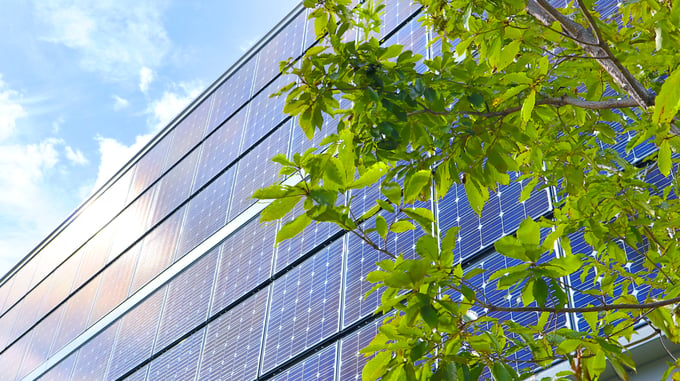Is the writing on the wall for REGO-backed green energy tariffs this year? We’ve long advocated a more granular approach to corporate renewable energy procurement – it’s the only way to drive meaningful change.
And it seems, the tide is turning. 2023 saw the market moving towards half-hourly energy matching – giving consumers a more accurate picture of when their consumption is met by carbon-free sources, at all times of the day. Let’s take a look at where we are now – and what to prepare for in 2024.
REGOs system reform in 2024?
The UK government has been promising reform to the REGOs system for some time, but among a backdrop of political uncertainty, progress has been slow. In summer 2023, it published the responses to its 2021 Call for Evidence on the energy retail market. There was a clear consensus in favour of REGOs reform.
It asked if the system of retrospective annualised matching, where a unit of consumption could be matched to any unit of renewable energy generated in the past 12 months, is working. The majority of respondents agreed that REGOs and the current system are not fit for purpose. Most people said that the system is not clear enough to consumers, many of whom wrongly believe that choosing a “green” tariff means supporting the build-out of new renewable energy projects.
The most common suggestions for reforming the energy retail market in the UK focused on the need for additionality, that is, proof that consumer’s choices drive the growth of renewables. REGOs are currently not achieving this; there is little connection between consumption of REGO-backed “100% renewable” energy and the development of renewable assets.
Many respondents emphasised the importance of data: better real-time information on the grid mix and half-hourly matching of consumption and generation. This is in line with what ENTRNCE has been calling for.
What to watch in 2024: the government says that following the consultation, it is “now undertaking a broader review of the REGO scheme”. It’s likely we’ll hear more on this in early 2024, so watch this space.
Sky-high REGO prices
Meanwhile, the financial case for REGOS has been crumbling. In October 2023, REGO prices hit a record high of £20. In November Trident Utilities reported that it was edging towards £25, with predictions that it would go beyond £30MWh before the end of 2023.
It’s unlikely that the price of REGOs will ever fall back below £1, for many good reasons, so green energy tariffs are no longer a “cheap” way to report zero Scope 2 emissions.
What to watch for in 2024: Experts predict that REGO prices could potentially reach £40/50/MWh in the coming years. Organisations are finding that the business case for taking control of their energy supply is more attractive than ever. Investing in on-site assets means that they are visibly supporting the generation of new renewable infrastructure. Securing a Corporate Power Purchase Agreement (CPPA) also offers a layer of additionality. Using our data platform, the Matcher, we’re working with businesses to simulate which clean energy options best suit their half-hourly consumption profile, so that they can take data-driven decisions on these big investments.
Suppliers moved towards greater transparency in 2023
Despite the sluggish pace of policy change, the energy retail market is already shifting towards a more meaningful way of energy sourcing and reporting.
In October 2023, Good Energy announced it would be the first UK supplier to provide time-based energy matching as standard to all of its half-hourly metered business customers. The supplier will show customers how their usage coordinates with the power produced by renewable generators on an hourly basis. The new service will pave a way to more accurate carbon reporting and enable businesses to shift when they use energy to reduce their emissions.
OVO also hit the headlines in April 2023 by announcing that it will stop investing in Renewable Energy Guarantee of Origin (REGO) certificates. It means the supplier will no longer be selling tariffs badged as “100% renewable” as standard. In a guest blog for ENTRNCE, OVO explained that they are instead focusing on customer support to decarbonise, which includes free or heavily discounted low carbon tech like smart thermostats, advice to improve home insulation, free tracking and support understanding energy usage, and being paid for shifting energy use to greener and cheaper times of the day.
What to watch for in 2024: More retailers are likely to adopt a more granular approach to energy tracing, as consumer calls for transparency grow.
Major energy users commit to 24/7 carbon-free energy
At COP28, the United States Federal Government, the nation’s largest energy user, signed the UN 24/7 carbon-free energy (CFE) compact, committing to match every hour of power consumption with carbon-free energy on every grid globally. They join 143 other signatories including Microsoft, Google, Mitsubishi and ENTRNCE – and the list is growing. In its latest report, Google also posted strong progress on its 24/7 carbon-free energy goal, with its facilities across the world matching an average of 64% of their energy consumption with local renewables in 2022.
What to watch for in 2024: Expect more major corporates public declare their intention to join the 24/7 CFE movement this year.
Make 2024 the start of your carbon-free energy journey
In 2024, ENTRNCE will continue to call for an energy retail market that offers real transparency for consumers. Our Matcher platform enables a data-driven approach that gives energy users the chance to make genuinely informed choices on their consumption.
If you want to join the growing movement of organisations working towards 24/7 carbon-free energy, we can help you get there. Let’s start a conversation in 2024.



